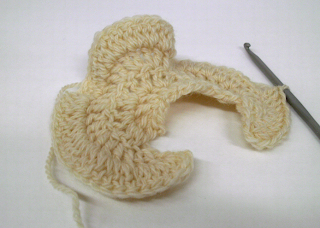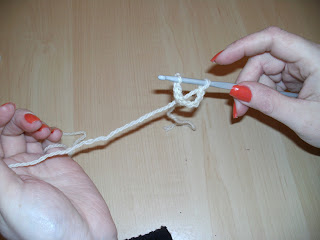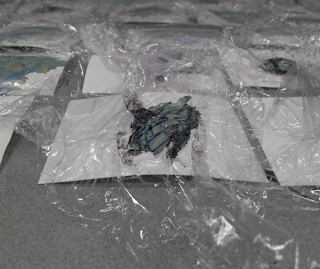Thursday, 9 February 2012
Wednesday, 8 February 2012
Systems Crochet
 |
| Grid made from yarn and pins |
 |
| (detail) |
 |
| In progress |
 |
| Finished |
 |
| Suspended from the middle point |
 |
| Worms-eye view |
ADD SCAN FROM NOTEBOOK
Crocheting with a system, mostly determined by rolling dice. Pinned to the wall as I reached each new co-ordinate. The system looked too rigid and structured, by hanging the piece I challenge the preconception of systems art. Juxtaposition of structure and natural flow/drape.
Tuesday, 7 February 2012
Hyperbolic Crochet llll
 | |
| Racetrack formation |
 |
| Curving in on itself |
 |
| Slight ruffling, due to 1 in 2 Increase |
The racetrack formation requires a specific start to enable the pattern to work:
- Ch10, turn
- 1 Treble in each
- 5 Trebles in end stitch
- Continue AROUND now using a 1 in 2 increase
- Continue increasing 1 in every 2 stitches until yarn runs out
Hyperbolic Crochet lll
 |
| Starting in a spiral formation |
 |
| Sample starting to look irregular |
 |
| Definate shape starting to emerge |
 |
| Well established sample, with the numbers that have formed it |
Crocheting in a spiral formation (round), putting a pre-determined amount of stitches into each stitch. Rolling a dice and following the numbers exactly led to this irregular sample.
Hyperbolic Crochet ll
 |
| Starting with Ch10, turn, 1 Treble into each, turn, 2 Treble in each |
 |
| Turn, 2 Treble in each stitch (repeat for the rest of the sample) |
 |
| The sample is beginning to ruffle slightly |
 |
| Sample when laid flat |
 |
| Sample allowed to curl |
 | |
| Finished sample, one ball of Rowan Pure Life DK |
Hyperbolic crochet can be worked in several different formations. Rather than working in the round, I have chosen to work in rows. Working in rows means a back and forth motion, rather than a continuous line. Turning at the end of each row gives the fabric a different texture compared to when it is worked in the round.
Saturday, 14 January 2012
Photoshop Polaroid
As discussed in my visual diary, I have decided to Photoshop my own photographs into Polaroid frames due to the cost of the obsolete technology.
Start by taking photographs on a digital camera, you are able to make more convincing images with photographs taken from a greater distance than is conventional.
Open the chosen image in Photoshop, and 'Select All' (keyboard shortcut for mac - CMD+A), then 'Copy' (keyboard shortcut for mac - CMD+C).
Meanwhile, open a file with a scanned Polaroid and select the photograph area using the area select tool.
Now, 'Edit', 'Paste special', 'Paste into'
The image will be far too large, so 'Edit', 'Free Transform' and proceed to scale down the image using the corner arrow tool and hold SHIFT at the same time so the image stays in proportion.
Carry on until the image fits nicely, which will depend on the original photograph.
Accept the transformation on the top bar by clicking the tick.
This would look much better if the original image would have been taken from a further distance.
Start by taking photographs on a digital camera, you are able to make more convincing images with photographs taken from a greater distance than is conventional.
Open the chosen image in Photoshop, and 'Select All' (keyboard shortcut for mac - CMD+A), then 'Copy' (keyboard shortcut for mac - CMD+C).
Meanwhile, open a file with a scanned Polaroid and select the photograph area using the area select tool.
Now, 'Edit', 'Paste special', 'Paste into'
The image will be far too large, so 'Edit', 'Free Transform' and proceed to scale down the image using the corner arrow tool and hold SHIFT at the same time so the image stays in proportion.
Carry on until the image fits nicely, which will depend on the original photograph.
Accept the transformation on the top bar by clicking the tick.
This would look much better if the original image would have been taken from a further distance.
Wednesday, 11 January 2012
Hyperbolic Crochet l
In simple terms, Hyperbolic Crochet is based around ratios of increase. Starting with any number of chain stitches and either working in the round or around a single line (rather than turning at the end of a row), increasing in a uniform pattern, gives a hyperbolic plane.
The first thing to do before starting to crochet is to set up your yarn, hook and hands to ensure perfect tension. For right handed crafters, wrap the yarn around your little finger on the left hand then pass it between your first finger and thumb, as a second tension guide. With the hook grasped lightly in the right hand, a slip knot acting as the first 'chain', hold onto the tail (short, non-working end) made by the slipknot.
Begin to chain stitch by wrapping the yarn around the hook once (I find that wrapping towards myself is most efficient) and pull this through the slip knot. The next chain stitch is made by wrapping the hook once and pulling this through the last chain stitch.
The first thing to do before starting to crochet is to set up your yarn, hook and hands to ensure perfect tension. For right handed crafters, wrap the yarn around your little finger on the left hand then pass it between your first finger and thumb, as a second tension guide. With the hook grasped lightly in the right hand, a slip knot acting as the first 'chain', hold onto the tail (short, non-working end) made by the slipknot.
 |
| Hand set-up for correct tensioning. |
 |
| Hook wrapped for next chain stitch. |
Note that the tail is now held by the left hand and the hook is worked solely by the right hand. A second tensioning wrap is also useful for taking up slack yarn and ensuring perfect tension. Use the tail (now made up of chain stitches) to aid smooth working of the hook.
 |
| Chain stitch completed. |
To join the 9 chain stitches into a round, ready for working in a spiral, put the hook back through the first chain stitch made (usually the slip knot). You should now have two loops on the hook.
 |
| First chain stitch on the hook. |
Wrap the hook once and pull through both stitches at once, this is a slip stitch. Note holding the chain loop to ensure good tension and easy use of the hook.
 |
| Chain now joined by a slip stitch |
This sample is being worked in Treble Crochet, Treble Crochet stitches are formed in the following way:
 |
| Wrap the hook and then insert it into the first front loop of the round. |
 | |
| Wrap the hook again and pull it through the first stitch only. |
You now have three loops on the hook
 |
| Wrap the hook again and pull it through the first two stitches |
 |
| Wrap the hook a final time and pull it through the last two stitches |
You now have a Treble Crochet stitch. A simple way to remember how to form these stitches is 'through one, through two, through two'
The following sample, continuing on from this starting chain loop of 9 stitches, is worked with a 'one in one increase'. A one in one increase assumes there will always be one stitch made for every stitch existing in the round. Therefore, one stitch is increased per stitch meaning two Treble Crochets will be made in every single stitch. This type of increase gives quite dramatic results early on.
Note the spiral formation of the sample, I have found this works best for hyperbolic forms. The alternative method is working in full joined rounds, chaining up to the next round.
Please also note the 'ribbed' lines between each round, this is done by picking up the front part of the stitch only rather than the conventional basic method which picks up both 'under the V'.
Subscribe to:
Posts (Atom)




















